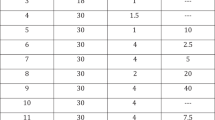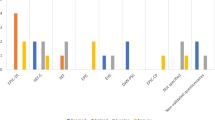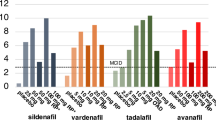Abstract
Baseline and follow-up data from 102 patients using intracorporeal (IC) injection for erectile dysfunction (ED) following RP were retrospectively collected. We compared baseline International Index for Erectile Function (IIEF) questionnaires with the abridged IIEF-5 questionnaires, referred to as the Sexual Health Inventory of Men (SHIM) to determine drug efficacy. The mean presurgery SHIM score was 21.75±5.23, which decreased to 4.23±3.48 after surgery and increased to 19.46±8.78 post-treatment. Overall, 68% (69/102) of patients achieved and maintained erections sufficient for sexual intercourse and 48% (49/102) of patients continued long-term therapy with a mean use of 3.7±1.9 y. In all, 52% (53/102) patients discontinued IC therapy. However when excluding patients who switched to oral therapy, had loss of partner or return of normal erections; the compliance to IC injections was 70.6% (71/102). There was no difference in the SHIM analysis between the nerve sparing (NS) and the non-NS or between the types of medications used. IC injections can provide excellent long-term efficacy and compliance in up to 70% of the patients. This study suggests that IC injections are an excellent salvage option in NS patients who fail oral therapy and a first option in patients with non-NS procedures.
This is a preview of subscription content, access via your institution
Access options
Subscribe to this journal
Receive 8 print issues and online access
$259.00 per year
only $32.38 per issue
Buy this article
- Purchase on Springer Link
- Instant access to full article PDF
Prices may be subject to local taxes which are calculated during checkout
Similar content being viewed by others
References
Porst H . The rationale for prostaglandin E1 in erectile failure: a survey of worldwide experience. J Urol 1996; 155: 802–815.
Cawello W et al. Pharmacokineticks of prostaglandin E 1 and its main metabolites after intacavernous injection and short term infusion of prostaglandin E1 in patients with erectile dysfunction. J Urol 1997; 158: 1403–1407.
Mulhall JP et al. The causes of patient dropout from penile self-injection therapy for impotence. J Urol 1999; 162: 1291–1294.
Zippe CD et al. Role of Viagra after radical prostatectomy. Urology 2000; 55: 241–245.
Linet OI, Ogrinc FG . Efficacy and safety of intracavernosal alprostadil in men with erectile dysfunction. N Eng J Med 1996; 334: 873–877.
Purvis K, Egdetveit I, Christiansen E . Intracavernosal therapy for erectile failure—impact of treatment and reasons for dropout and dissatisfaction. Int J Impot Res 1999; 11: 287–299.
Montorsi F et al. Recovery of spontaneous erectile function after nerve sparing radical retropubic prostatectomy with and without early intracavernous injections of alprostadil: results of a prospective, randomized trial. J Urol 1997; 158: 1408–1410.
Dennis RL, McDougal WS . Pharmacological treatment of erectile dysfunction after radical prostatectomy. J Urol 1988; 139: 775–776.
Rodriguez VL et al. Erectile dysfunction after radical prostatectomy. Etiopathology and treatment. Actas Urol Esp 1997; 21: 909–921.
Irwin MB, Kata EJ . High attrition rate with intracavernous injection of prostaglandin E1 for impotency. Urology 1994; 43: 84–87.
Vardi Y, Sprecher E, Gruenwald I . Logistic regression and survival analysis of 450 impotent patients treated with injection therapy: long-term dropout parameters. J Urol 2000; 163: 467–470.
Sexton WJ, Benedict JF, Jarow JP . Comparison of long-term outcomes of penile prosthesis and intracavernosal injection therapy. J Urol 1998; 159: 811–815.
Lakin MM et al. Prostaglandin E1 injection therapy for post-prostatectomy impotence: an outcome analysis. J Urol 1996; 155: 639–643.
Evans C . Complications of intracavernosal therapy for impotence. In: Carson C, Kirby R, Goldstein I (eds). Textbook of Erectile Dysfunction. Isis Medical Media: Oxford, 1999, pp 365–370.
Ajay Nehra . Intracavernosal therapy: when oral agents fail. Cur Urol Rpt 2001; 2: 468–472.
Rosen RC et al. The International Index of Erectile Function (IIEF): a multidimensional scale for assessment of erectile dysfunction. Urology 1997; 49: 822.
Rosen RC et al. Development and evaluation of an abridged 5-Item version of the International Index of Erectile Function (IIEF-5) as a diagnostic tool for erectile dysfunction. Int J Impot Res 1999; 11: 319–326.
Bechara A et al. Prostaglandin E1versus mixture of prostaglandin E1, papavereine and phentolamine in non-responders to high papaverine plus phentolamine doses. J Urol 1996; 155: 913–914.
Burnett AL . Nitric oxide in the penis: physiology and pathology. J Urol 1997; 157: 320–324.
Burnett AL . Nitric oxide regulation of penile erection: biology and therapeutic implications. J Androl 2002; 23: S20–S24.
Ajay Nehra, Irwin Goldstein . Sildenafil citrate after radical retropubic prostatectomy: con. Urology 1999; 54: 587–589.
De la Taille A, Delmas V, Amar E, Boccon-Gibod L . Reasons for dropout from short-and long-term self-injection therapy for impotence. Europ Urol 1999; 35: 312–317.
Mc Mohan CG . A pilot study of role of intracavernous injection of vasoactive intestinal peptide and phentolamine in the management of erectile failure. Int J Impot Res 1996; 8: 233–236.
Mullhall JP et al. Intracavernosal forskalin: role in management of vasculogenic impotence resistant to 3-agent pharmacotherapy. J Urol 1997; 158: 1752–1758.
Buvat J et al. Double blind multicenter study comparing alprostadil alpha-cyclodextrin with moxisylyte chlorohydratein chronic organic erectile dysfunction. J Urol 1998; 159: 116–119.
Raina R et al. Management of erectile dysfunction following radical prostatectomy. Curr Urol Rpt 2001; 2: 495–503.
Author information
Authors and Affiliations
Corresponding author
Rights and permissions
About this article
Cite this article
Raina, R., Lakin, M., Thukral, M. et al. Long-term efficacy and compliance of intracorporeal (IC) injection for erectile dysfunction following radical prostatectomy: SHIM (IIEF-5) analysis. Int J Impot Res 15, 318–322 (2003). https://doi.org/10.1038/sj.ijir.3901025
Received:
Revised:
Accepted:
Published:
Issue Date:
DOI: https://doi.org/10.1038/sj.ijir.3901025
Keywords
This article is cited by
-
Men’s beliefs about treatment for erectile dysfunction—what influences treatment use? A systematic review
International Journal of Impotence Research (2021)
-
Erection rehabilitation following prostatectomy — current strategies and future directions
Nature Reviews Urology (2016)
-
What is the current role of intracavernosal injection in management of erectile dysfunction?
International Journal of Impotence Research (2016)
-
Sexual dysfunction after cystectomy and urinary diversion
Nature Reviews Urology (2014)
-
Experience with intracavernous injection in the treatment of erectile dysfunction after radical prostatectomy: dose considerations
International Journal of Impotence Research (2011)



